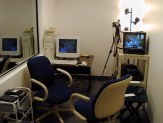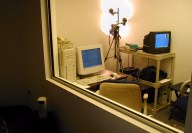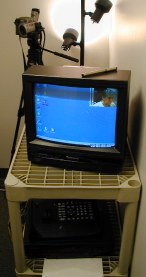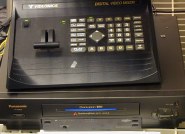danbricklin.com/log
|
||
|
|
Starting March 28, 2000
The RIM keyboard and time trials, Permanent links to this log, Good pictures for the web, Behind the one-way mirror, Judge Jackson's decision, Trellix gets more money, A review of Michael Schrage's book "Serious Play"
28Mar-12Apr00
2000_03_28.htm
|
|
Wednesday, April 12, 2000
The RIM keyboard and time trials
Yesterday, Research in Motion Limited (RIM) announced a new device to compete with the Palm PDAs, the new RIM 957. RIM's devices use tiny keyboards you operate with your thumbs, and a clickable roller wheel that makes the UI work well.
Older RIM 950, roller wheel
I decided to test out the speed of various input devices for handheld equipment. To learn more about the RIM devices, and to see the test results, read my RIM Keyboard writeup. Bottom line? QWERTY rules! Even tiny keyboards can be very useful if the UI is right. The PC is not the only device that should have a keyboard.
Monday, April 10, 2000
Permanent links to this log
People have complained that they can't link to postings on my home page because the URL changes when I move the material into the archives as the home page fills up. I've tried having an interim page with the URL of the soon-to-be archive page with a link back to the home page. That doesn't seem to be enough. To try something that may be better, I've now changed the interim page that will eventually get the material shown on this home page to have an automatic browser refresh back to the home page. If you want to link to something you see here that is currently on the home page and want the link to continue to point to the same material after I move it off of the home page, you can link to that placeholder page. I'll list the URL at the bottom of the home page. Let me know what you think.
Good pictures for the web
Paul Simpson over in Trellix technical support asked me to write a little piece for his newsletter's "Dan Speaks" column about getting pictures ready for a web site. Trying to put the little time I have to write to good use, I'll post it up here,too. (Since it's a publication for Trellix Web users, I mention Trellix related details.)
If you are new to posting photographs on the web, here are some simple rules of thumb to keep download times short and viewer satisfaction up:
Thursday, April 6, 2000
Behind the one-way mirror
A lot of my time these days goes to watching potential users try the products we have in development. At Trellix Corporation we often do that in our usability lab. Today, watching the Nth person try yet another incarnation of one of our new utilities, I decided to bring in the laptop and write while I watch.
You learn an awful lot from a usability lab. You give people tasks ("Try this product and make a web site") and watch them. We do it with one of our people in the room with the tester. Our person encourages the tester to say what they are thinking, telling us what's confusing, what they are trying to do, and helping them around unimplemented or buggy features, etc. You have to remind people that they are not being tested, our software is. They can't "fail" any more than someone testing a new drug for effectiveness can "fail".
While some companies spend millions building fancy usability labs, we did ours quite simply and inexpensively. We used two small adjacent offices. In our old building we split one office in half with a new wall. In both cases it was an "undesirable" windowless office. The main expense was having a "one-way" mirror installed in the wall. This setup lets interested observers watch the tests live.
Here's the testing room, viewed from the hallway and through the door to the testing room:
  Doors to usability lab and observing room; inside the lab
This is the testing room viewed through the mirror in the observer room. On the near side of the mirror you can see a little speaker that lets observers hear what's going on:
 Through the one-way mirror
There's a lot of equipment in the testing room. There is a PC to run the software being tested. It's connected to a scan converter that turns the SVGA image on the computer screen into a video signal. The other equipment includes a microphone near the computer screen, a camcorder used as a simple video camera, an SVHS VCR (more resolution than a normal VHS one), a little box that produces an image of a digital clock, and a special effects box:
 The recording equipment
The special effects box (an inexpensive one like those used by wedding videographers) is used to mix the PC screen, the time clock, and the image of the tester's face into one video feed into the VCR for later review:
  Special effects box and VCR; Images combined on TV screen
This whole setup is not very expensive. Besides the PC, the unusual equipment we have includes a very good scan converter (I'm told this is important, we paid over $1,000), the special effects box (less than $1,000), and the time code device (about $500). VCR and camera were home units. We paid less than $2,000 to make an opening in the wall and install the mirror. We've run the same setup in a conference room without the separate viewing area or mirror, but I like the ability to have observers come in and out. The testers seem to ignore the mirror and the people behind it, believe it or not.
To learn more about usability testing, see Keith Instone's Usable Web, Jakob Nielsen's useit.com, and User Interface Engineering's (UIE) web site. UIE, founded in 1988 by Jared Spool (whom I first met when I did a summer internship at Prime Computer in 1978 and we were both kids), helped us determine which particular equipment to buy.
Tuesday, April 4, 2000
Judge Jackson's decision
Now that the verdict is finally in, I get asked "What does this mean to Trellix and the industry?" My answer is: I don't know.
There are so many variables that it's really hard to tell what will matter most and whether this is good or bad for the industry or Microsoft. It will take quite a bit of time for a "final" decision after all the appeals. The world is reacting to Microsoft's power (now even more clearly documented) by trying to embrace alternatives, or at least not letting them die. Microsoft is making some changes, either in good faith or just to look good, that may have effects. The new communications-based infrastructure for society that is being built around the Internet encourages a more varied set of devices and applications than the PC-based infrastructure that gave rise to Microsoft's power. Many of the talented and driven people who made Microsoft what it is have left to start other ventures and some will be successful. There still is little alternative in most users' eyes to Microsoft products, but the need to upgrade is getting less and less as we create the new functionality outside of the PC instead of inside it.
In any case, our industry gets more interesting all the time, and its size, volatility and importance keep it in the public eye.
If you haven't read my comments about Ethical issues and monopolies (written after the Findings of Fact last year), you may find it of interest today.
Trellix gets more money
Hopefully not lost in the hoopla about the Microsoft case, the company I founded and work for, Trellix Corporation, announced yesterday that it raised $35 million in a mezzanine round of financing led by Goldman Sachs. We'll put it to good use making great tools for regular people to create their own web sites and to provide those tools through others.
Tuesday, March 28, 2000
A review of Michael Schrage's book "Serious Play"
I just finished reading a new book by Michael Schrage: Serious Play: How the World's Best Companies Simulate to Innovate. I helped contribute material, and Michael gave me a personally dedicated copy at PC Forum 2000.
I really like this book, and I recommend it to anyone interested in learning more about innovation. I wrote a review that also explains why prototyping is important to me and how I learned its value.
Read my review of Serious Play.
Here's a picture of Michael telling me my copy will make it to the conference by the next day (like software products, it took longer). Also, a copy of the cover, linked to Amazon.com in case you'd like to reward me for telling you about the book by letting me get an affiliate payment, or want to see what others have to say:
Michael Schrage at PC Forum 2000; book cover, with link to Amazon.com
|
||
|
© Copyright 1999-2018 by Daniel Bricklin
All Rights Reserved.
|
||



